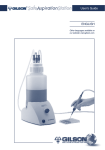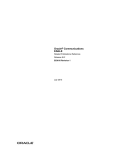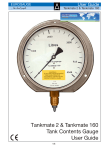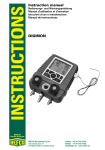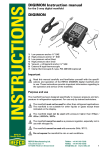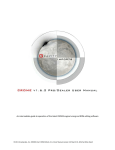Download ENGLISH User's Guide
Transcript
User’s Guide ENGLISH 1 safety symbols used 3 2 intended use 3 3 safety notes 3 3 3 4 Possible dangers associated with noncompliance... Safety-conscious working Safety notes for the user organization 4 changes in design or configuration 4 5 description This equipment generates, uses and can radiate radio frequency energy and, if not installed and used in accordance with the User’s Guide, may cause harmful interference to radio communications. Front view Rear view 6 Installation Scope of supply Installation location and power supply connection Operation of this equipment in a residential area is likely to cause harmful interference in which case the user will be required to correct the interface at his own expense. 4 4 5 5 5 5 7 usING the gilson safe aspiration station 6 Preparing Switching ON Operation EC- Declaration of Conformity We declare under our sole responsability that this product corresponds to the regulations 89/336/ EEC, 73/23/ EEC, 2002/95/ EC and 2002/96/ EC and conforms with the standards or standardized documents EN 61010-1: 2001-02 and EN 61326-1 +A1: 1998 +A2: 2000. 8 level detection Operation and Instructions on use Activation and deactivation Calibration of level detection 9 Maintenance and cleaning Maintenance Cleaning Warranty 6 6 6 7 7 8 8 8 8 9 10 autoclaving & chemical sterilisation 9 Gilson warrants this product against defects in material under normal use and service for a period of 12 months from the date of purchase. 11 equipment disposal Gilson is not responsible for incidental damage resulting from physical shock, continuous exposure to corrosive reagents or technical handling not in accordance with the guidelines described in the user’s guide. 9 12 troubleshooting (faq) 10 13 technical data 10 14 spare parts and accessories 11 15 manufacturer and customer service 11 -- ENGLISH 1 Safety symbols used This manual contains the following symbols, compliance with which is essential. The symbols signify the following: DANGER Indicates possible danger of personal injury or death. Comply with the instructions. DANGER biological risks Indicates possible biological risk. Comply with the instructions. CAUTION Indicates possible damage to the instrument. Comply with the instructions. NOTE Provides important notes on the correct operation of the Gilson Safe Aspiration Station. 2intended use Gilson Safe Aspiration Station is a laboratory unit with an adjustable vacuum for controlled, contamination-free removal by suction of non-explosive aqueous liquid substances. Any application other than this purpose is regarded as inappropriate! 3 Safety notes Possible dangers associated with noncompliance with the safety notes Gilson Safe Aspiration Station represents the current state of the art and is safe in operation. There are residual risks involved if this equipment is operated by untrained persons. All persons using the Gilson Safe Aspiration Station must read the operating instructions and the safety notes before starting to work with the equipment. Safety-conscious working Irrespective of the safety instructions listed here, compliance is required with additionally applicable national regulations, e.g. of GLP, GMP, trade associations, public health department and factory inspectorate. -- Safety notes for the user organization Supervisors of the operating personnel must have read and understood the safety notes and safety-relevant points of the operating instructions. They must ensure that the operating personnel have understood and are complying with the safety notes. 4changes in design or configuration Gilson Safe Aspiration Station shall not be modified. Defective parts shall be exchanged only for original spare parts from Gilson. Gilson Safe Aspiration Station shall not be modified either as equipment or with regard to the safety aspects. Any modification will result in exclusion of responsibility for consequential injury or damage on the part of Gilson. Gilson Safe Aspiration Station must not be opened! Repairs shall be carried out only by Gilson or an authorized customer service organization. 5 DeSCrIPtion Gilson Safe Aspiration Station is an adjustable suction device with an integral pump and adjustable, electronic vacuum controller for laboratory use. The instrument shall not be used for applications other than those specified. Front View Gilson Safe Aspiration Station instrument Control for setting vacuum / suction power ON/OFF switch with green indicator lamp Vacuum bottle Bottle lid Hand operator Quick couplings Level detection sensor cable -- Figure 1 ENGLISH Rear View Push-button for level detection calibration Socket for level detection sensor cable Socket for cable mains adapter Connection for filter Air outlet If the level detection is not in use, position 1 and 2 don’t have any functions. Figure 2 6installation Scope of supply Check all components against the scope of supply and ensure that they are complete and undamaged: Installation location and power supply connection Gilson Safe Aspiration Station is designed for use in a laboratory environment. It should be installed in a level, dust-free and dry location. Component Part Number Gilson Safe Aspiration Station Mains adapter with 4 primary adapters Bottle 4L polypropylene (PP) Lid for PP-bottle with quick couplings and level detection Level detection sensor cable Tubing set with filter Hand operator Gilson Safe Aspiration Station User’s Guide Gilson Safe Aspiration Kit Instruction Leaflet F110741 -F1077411 F1077412 F1077419 F1077415 -LT801505 LT801506 Power supply connection: • Fit the mains adapter with the primary adapter suitable for your power line socket outlet. • Plug the mains adapter into the socket outlet and connect it to the Gilson Safe Aspiration Station. The supply voltage must comply with the requirements listed in the ‘Technical data’ under ‘Power supply’! -- 7 usING the Gilson safe aspiration station Preparing • Vacuum bottle preparation: Fit the lid with the quick couplings onto the bottle. Ensure that the lid is screwed on firmly! • Connecting the vacuum bottle to the instrument: Connect the filter to the connection on the device. The dot marked on the filter must be towards the device. Note the following symbol at the input to the device: Connect the filter with the short tube to the blue coupling on the lid of the vacuum bottle. • Connect the vacuum bottle to the hand operator: Connect the tube from the hand operator, or from another suction tool, to the red quick coupling on the lid of the vacuum bottle. • Connect the level detection sensor cable: Connect the sensor cable between the socket Sensor at the rear and bottle lid. Calibrate the level detection according to chapter 8.3. Figure 3 Switching on Pay attention to the following notes before operation: Always screw the lid on tightly! The seal in the lid can only function correctly when it is adequately compressed.To build up the vacuum, the lid venting must be sealed. Put on the sealing plug respectively venting screw tightly. Actuate the power switch. When the instrument is switched on, the green indicator lamp lights up. Operation The control knob allows smooth adjustment of the suction power. An indication of the suction power is provided by the scale: • Small dots Low vacuum/low suction power. • Large dots High vacuum/high suction power. -- ENGLISH Check the content’s level of the vacuum bottle before you start work. Before starting the suction, check that there is sufficient free volume in the bottle for the amount of liquid. Do not overfill the bottle. Prevent the liquid or foam from the vacuum bottle from being sucked into the filter thereby blocking it and thus limiting its safety function. In case the filter gets accidentally wetted or soiled it has to be changed immediately, otherwise retention of liquids can not be guaranteed. Note that the hydrophobic filter holds back aqueous solutions, whereas retention of apolar liquids is limited. To prevent the build-up of foam, we recommend the use of normal commercial anti-foaming agents. When working with dangerous substances, you must comply with their safety instructions, the applicable national regulations, e.g. of GLP, GMP, trade associations, public health department and factory inspectorate. In addition, when working with hazardous volatile substances or biohazardous agents either place the Gilson Safe Aspiration Station inside a laminar flow cabinet or connect the instrument’s air outlet to the ventilation of the laminar flow cabinet by means of a tube and of a connector (Part Number F1077417). If the equipment does not operate correctly, you will find information in the section ‘Troubleshooting (FAQ)’. 8 level detection Operation and instructions on use The level detection connected to the Gilson Safe Aspiration Station prevents foam or liquid from entering the filter or the instrument during aspiration. As soon as foam or liquid is detected, the pump switches off and an audible alarm (once a second) is activated. The green indicator lamp of the main switch blinks synchronously. Instrument, sensor cable and bottle lid constitute an assembly and they must be calibrated to match one another. Depending on the degree of soiling on the lid of the bottle it may be necessary to calibrate the level sensor periodically. If you have more than one lid / Gilson Safe Aspiration Station and accidentally swap the lids, it may be necessary to recalibrate the systems. It is absolutely essential that you prevent instrument and sensor cables from being swapped over accidentally. Otherwise you will have to recalibrate. To ensure that the level detection operates properly no foam must form! To avoid the formation of foam, we recommend using standard anti-foaming agents. -- Activation and deactivation Electronics in the instrument detects automatically a sensor cable. If a sensor cable is connected, the level detection is activated. According to this, if no sensor cable is connected, the level detection is deactivated. If a sensor cable is connected on switching on the Gilson Safe Aspiration Station it will be confirmed by an audible double beep. It is possible to activate / deactivate the level detection during operation by connecting / disconnecting the sensor cable. It will be confirmed also by an audible double beep. Calibration of level detection To calibrate the level detection proceed as follows: • Connect the sensor cable between the socket ‘Sensor’ at the rear of the instrument and the bottle lid. • Make sure the sensor pins in the lid are dry and unsoiled. • Turn on Gilson Safe Aspiration Station at the power switch. • If the sensor cable is properly connected a double beep is produced. A possibly upcoming level detection alarm can be ignored. • Press the ‘Calibration’ button at the rear at least for one second until a short beep is heard. • If calibration has failed, you will continuously hear an alarm tone (two beeps per second) and the green indicator lamp on main switch blinks synchronous. Check if the cable is correctly connected to the device and the lid (fully inserted). Clean and dry the lid, the sensor pins and the space between the pins and repeat the calibration procedure. It is possible to start a calibration during operation. Check if the sensor pins in the lid are dry and unsoiled. Heavy electromagnetic interferences can produce an incorrect level detection alarm. This alarm will disappear when the interference is inactive. 9 maintenance and cleaning Maintenance No special servicing or maintenance is necessary. If there is a reduction in suction power, this may be caused by blockages in the tube and filter on the pump side. These can be remedied by exchanging the parts affected. Ensure that the dot marked on the filter is towards the instrument. -- ENGLISH Cleaning Dirt can be cleaned off with a cloth moistened with soapy water or up to 70% alcohol. You can wash the bottle and lid (without sensor cable) in a dish washer. For the connection of the sensor cable keep clean the contact pins at the bottle lid.Clean and dry the interior of the lid between the sensor pins. Before cleaning the equipment, remove the plug from the power supply. Never use aggressive solutions such as nitro thinners, acetone etc. 10 autoclaving and chemical sterilisation Bottle, lid, tubes and filter can be autoclaved to max. 121°C. During the autoclaving process, screw the lid onto the bottle only loosely. When chemical sterilisation methods are employed, it is recommended to use disinfectants free or chlorine or other corrosive agents, especially when corrosive vapours might be generated and aspirated. Always disconnect quick connectors before autoclaving. Otherwise they will be damaged. The instrument, the mains adapter and the sensor cable must not be autoclaved! 11equipment disposal The Gilson Safe Aspiration Station is labelled with the “crossed-out wheeled bin” symbol to indicate that this equipment must not be disposed of with unsorted municipal waste. Instead, it is your responsibility to correctly dispose of your waste equipment by handing it over to an authorised facility for separate collection and recycling. It is also your responsibility to decontaminate the equipment in case of biological, chemical, and/or radiological contamination so as to protect from health hazards the persons involved in the disposal and recycling of equipment. For more information about where you can drop off your waste equipment for recycling, please contact your local dealer from whom you originally purchased the product or your local council. By doing so, you will help conserve natural resources and you will ensure that your waste equipment is recycled in a manner that protects human health and the environment. Thank you! -- 12troubleshooting (faq) Problem Possible Cause Remedy Equipment not running, No power line voltage. no vacuum. No DC supply. Pump switched off. Insert mains adapter plug into a suitable power line socket outlet. Connect mains adapter to instrument. Switch on device. Green LED indicator must light up! Suction power inadequate Suction power selected too low. or pump runs constantly. Leak in vacuum system. Bottle full, liquid sucked up to the filter. Tubes blocked. Filter blocked. Turn control knob clockwise. Check lid and tighten if necessary. Check if sealing plug/venting screw on bottle lid is leaking. Fit the filter tightly on main unit. Leak flow of aspiration tool possible too large. Remove the filter from the instrument. Empty bottle or exchange it for an empty one. Exchange filter. Clean or exchange tubes. Exchange filter. Alarm level detection. Sensor cable incorrectly connected. The medium or foam in the bottle has reached maximum level. Level detection is not calibrated. Incorrect calibration (double beep). The lid interior between the sensor pins is soiled. Check if the cable is correctly connected to the device and the lid (fully inserted). Empty the bottle. Use antifoam agent. Calibrate level detection. Check sensor pins, sensor cable and connector. Retry calibration (see also chapter 8). Clean and dry the interior of the lid between the sensor pins. 13technical data Equipment type Dimensions (LxWxH) Weight Vacuum Pump output Control Indicator Laboratory unit with adjustable vacuum for controlled, contamination-free suction removal of liquids. Instrument 255 x 180 x 150 mm With PP-Bottle 4L, filter and tubes: 320 x 180 x 530 mm 2.0 kg -300 to -600mbar relative, smoothly adjustable approx. 8 L/min air under atmospheric conditions Microprocessor controlled, adjustable vacuum control Green LED indicator lit when unit ON - 10 - ENGLISH Power supply Mains adapter: Input voltage: 100 - 240 VAC 50/60 Hz; CE, UL, Protective Class II, Degree of Protection IP414 primary connectors for EURO, UK, US/JAP, AUS Output voltage: 18 VDC, 0.84 A, short-circuit proof Instrument: 18 VDC 0.66A Noise level Typ. < 50 dB(A) at a distance of 1m Bottle 4L Polypropylene bottle Level detection Capacitive measuring principle Material Quick couplings Body: PVDF, Spring: stainless steel, Seal: FPM (Viton) Ambient conditions Operation 5 to 40°C, max 80% RH Storage -10 to 50°C, max 95% RH Degree of protection IP 21 Filter Hydrophobic membrane filter, non-sterile, diameter 60 mm, 0.45µm 14 spare parts and accessories Gilson Safe Aspiration Station spare parts/accessories Bottle 4 litre Polypropylene, incl. lid with quick couplings and level detection Bottle 4 litre Polypropylene (PP) Lid for Polypropylene bottle with quick couplings and level detection Tubing 1800 mm bottle lid – hand operator Tubing 700 mm instrument – bottle Tubing set with filter (consists of Part Number F1077413, F1077414 and F1077416) Hydrophobic membrane filter, non-sterile, diameter 60 mm, 0.45µm Pump exhaust tubing connector Y-tubing connector Level detection sensor cable Gilson Safe Aspiration Kit, hand operator set Part Number F1077410 F1077411 F1077412 F1077413 F1077414 F1077415 F1077416 F1077417 F1077418 F1077419 F110742 15 MANUFACTURER AND CUSTOMER SERVICE Manufacturer: Customer service: Gilson SAS 19 avenue des Entrepreneurs, BP 145 95400 Villiers-le-Bel, France www.gilson.com Please contact your local Gilson distributor. You will find their name and address on our web site www.gilson.com - 11 - LT801505/B - ©2007 Gilson SAS All rights reserved English February 2007 Printed in France World Headquarters Gilson, Inc. 3000 Parmenter Street, P. O. Box 620027, Middleton, WI 53562-0027, USA Telephone: (1) 800-445-7661 or (1) 608-836-1551 Fax: (1) 608-831-4451 Gilson SAS 19 avenue des Entrepreneurs, B. P. 145, 95400 Villiers-le-Bel, France Telephone: (33) 1-34-29-50-00 Fax: (33) 1-34-29-50-20












